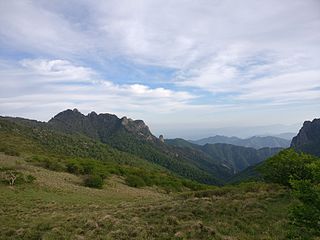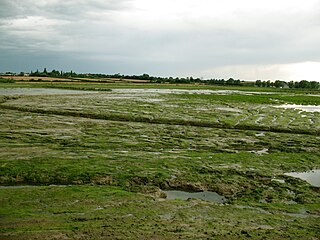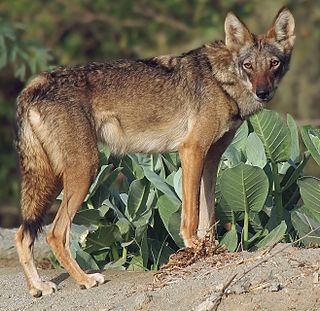Related Research Articles

The brown bear is a large bear species found across Eurasia and North America. It is one of the largest living terrestrial members of the order Carnivora, rivaled in size only by its closest relative, the polar bear, which is much less variable in size and slightly bigger on average. Adults of different subspecies range in weight from 80 to 600 kg, with males being heavier than females. Despite its name, brown bears aren't entirely brown; the pelage can be reddish to yellowish-brown, and dark brown to cream in color. During winter, brown bears in some populations hibernate and emerge during spring to regain up to 180 kg (400 lb) of weight. They have well developed dentition and claws, ideal for their lifestyle.

The leopard is one of the five extant species in the genus Panthera. It has a pale yellowish to dark golden fur with dark spots grouped in rosettes. Its body is slender and muscular reaching a length of 92–183 cm (36–72 in) with a 66–102 cm (26–40 in) long tail and a shoulder height of 60–70 cm (24–28 in). Males typically weigh 30.9–72 kg (68–159 lb), and females 20.5–43 kg (45–95 lb).

The honey badger, also known as the ratel, is a mammal widely distributed in Africa, Southwest Asia, and the Indian subcontinent. Because of its wide range and occurrence in a variety of habitats, it is listed as Least Concern on the IUCN Red List.

The Qinling or Qin Mountains, formerly known as the Nanshan, are a major east–west mountain range in southern Shaanxi Province, China. The mountains mark the divide between the drainage basins of the Yangtze and Yellow River systems, providing a natural boundary between North and South China and support a huge variety of plant and wildlife, some of which is found nowhere else on earth.

An apex predator, also known as a top predator, is a predator at the top of a food chain, without natural predators of its own.

The Holarctic realm is a biogeographic realm that comprises the majority of habitats found throughout the continents in the Northern Hemisphere. It corresponds to the floristic Boreal Kingdom. It includes both the Nearctic zoogeographical region, and Alfred Wallace's Palearctic zoogeographical region.

Managed retreat involves the purposeful, coordinated movement of people and buildings away from risks. This may involve the movement of a person, infrastructure, or community. It can occur in response to a variety of hazards such as flood, wildfire, or drought. Politicians, insurers, and residents are increasingly paying attention to managed retreat from low-lying coastal areas because of the threat of sea level rise due to climate change. Trends in climate change predict substantial sea level rises worldwide, causing damage to human infrastructure through coastal erosion and putting communities at risk of severe coastal flooding.

The Marine Mammal Protection Act (MMPA) was the first act of the United States Congress to call specifically for an ecosystem approach to wildlife management.

The Arabian wolf is a subspecies of gray wolf native to the Arabian Peninsula—to the west of Bahrain, as well as Oman, southern Saudi Arabia, and Yemen. They are also found in Israel’s Negev and Arava Deserts, Jordan, Palestine, and Egypt's Sinai Peninsula. It is the smallest Gray wolf subspecies, and a specialized xerocole (arid-adapted) animal that normally lives in smaller familial packs. Arabian wolves are omnivorous and opportunistic eaters; they consume small to medium-sized prey, from insects, reptiles and birds to rodents and small ungulates, such as young Nubian ibex and several species of gazelle.

Grant's gazelle is a relatively large species of gazelle antelope, distributed from northern Tanzania to South Sudan and Ethiopia, and from the Kenyan coast to Lake Victoria. Its Swahili name is swala granti. It was named for a 19th-century British explorer, James Grant.

The binturong, also known as the bearcat, is a viverrid native to South and Southeast Asia. It is uncommon in much of its range, and has been assessed as Vulnerable on the IUCN Red List because of a declining population. It is estimated to have declined at least 30% since the mid-1980s. The binturong is the only species in the genus Arctictis.

Katherine Jane Willis, Baroness Willis of Summertown, is a British biologist, academic and life peer, who studies the relationship between long-term ecosystem dynamics and environmental change. She is Professor of Biodiversity in the Department of Biology and Pro-Vice-Chancellor at the University of Oxford, and an adjunct professor in biology at the University of Bergen. In 2018 she was elected Principal of St Edmund Hall, and took up the position from 1 October. She held the Tasso Leventis Chair of Biodiversity at Oxford and was founding Director, now Associate Director, of the Biodiversity Institute Oxford. Willis was Director of Science at the Royal Botanic Gardens, Kew from 2013 to 2018. Her nomination by the House of Lords Appointments Commission as a crossbench life peer was announced on 17 May 2022.

Erle Christopher Ellis is an American environmental scientist. Ellis's work investigates the causes and consequences of long-term ecological changes caused by humans at local to global scales, including those related to the Anthropocene. As of 2015 he is a professor of Geography and Environmental Systems at the University of Maryland, Baltimore County where he directs the Laboratory for Anthroecology.

Yadvendradev Vikramsinh Jhala is an Indian scientist and conservationist who recently ended his tenure as the Dean at the Wildlife Institute of India in Dehradun.
Luigi Boitani is a professor of zoology at the Sapienza University of Rome, whose research interests include ecology, the protection of large mammals, and the management of protected areas. Boitani is president of the Large Carnivore Initiative for Europe.
SDSS J1228+1040 b is an extrasolar planetesimal orbiting the white dwarf SDSS J1228+1040. It was discovered in 2019 using the variable calcium Ca II emission line.
Adina Merenlender is a Professor of Cooperative Extension in Conservation Science at University of California, Berkeley in the Environmental Science, Policy, and Management Department, and is an internationally recognized conservation biologist known for land-use planning, watershed science, landscape connectivity, and naturalist and stewardship training.
Beatriz Rico is a professor of developmental neurobiology at King's College London. Her research focuses on neural circuit development.
Amelia Jane Dickman is Professor of Wildlife Conservation and Director of WildCRU at the University of Oxford, Kaplan Senior Research Fellow at Pembroke College, Oxford and joint CEO of Lion Landscapes. She is best known for her leadership of the Ruaha Carnivore Project, seeking to improve conservation outcomes for lions and other carnivores in the Ruaha National Park of Tanzania. She is known for her views on the importance of scientific and local community input into discussions around the continued importance of trophy hunting for the conservation of African landscapes.

Megaherbivores are large herbivores that can exceed 1,000 kg (2,200 lb) in weight. They first appeared 300 million years ago in the early Permian, in the form of synapsids. They were then replaced by megaherbivorous dinosaurs that went extinct in the Cretaceous-Paleogene extinction event. After this period, small mammalian species evolved into large herbivores in the Paleogene. During the Quaternary Extinction Event, megaherbivores disappeared on most continents on Earth. Recent megaherbivores include elephants, rhinos, hippos, and giraffes. There are nine extant species of terrestrial megaherbivores living in Africa and Asia. The African bush elephant is the largest extant species.
References
- ↑ SFGATE, Ashley Harrell (2021-11-12). "What it's like to be a carnivore expert who can give CPR to bears". SFGATE. Retrieved 2023-05-17.
- 1 2 "Rae Wynn-Grant". National Geographic Expeditions. 11 November 2019. Retrieved December 16, 2020.
- 1 2 3 Society, National Geographic. "Learn more about Rae Wynn-Grant". admin.nationalgeographic.org. Retrieved 2020-12-16.[ dead link ]
- ↑ Shufro, Cathy (20 December 2019). "Where the Bears Were". Yale School of the Environment. Retrieved 2020-12-16.
- ↑ Wynn-Grant, Rae; Ginsberg, Joshua R.; Lackey, Carl W.; Sterling, Eleanor J.; Beckmann, Jon P. (2018-10-01). "Risky business: Modeling mortality risk near the urban-wildland interface for a large carnivore". Global Ecology and Conservation. 16: e00443. doi: 10.1016/j.gecco.2018.e00443 . ISSN 2351-9894.
- ↑ 🐌 Crash Course Zoology Preview , retrieved 2021-04-15
- ↑ What is an Animal? Crash Course Zoology #1 , retrieved 2021-04-15
- ↑ "Explore the New Reebok x National Geographic Shoe Collection That's Inspired By Nature". Mental Floss. 2021-11-03. Retrieved 2023-05-18.
- ↑ "Going Wild with Dr. Rae Wynn-Grant | Podcast | Nature | PBS". Nature. Retrieved 2022-10-28.
- ↑ "NEW Webby Gallery + Index". NEW Webby Gallery + Index. Retrieved 2022-10-28.
- ↑ "#IfThenSheCan – The Exhibit". ifthenexhibit.org. Retrieved 2020-12-16.
- ↑ "Home Page | AAAS IF/THEN Ambassadors Program". ifthen.aaas.org. Retrieved 2020-12-16.
- ↑ Kean, Sam (2019-04-05). "Science's debt to the slave trade". Science. 364 (6435): 16–20. Bibcode:2019Sci...364...16K. doi:10.1126/science.364.6435.16. ISSN 0036-8075. PMID 30948535. S2CID 96435139.
- 1 2 Wynn-Grant, Rae (2019-09-20). "On reporting scientific and racial history". Science. 365 (6459): 1256–1257. Bibcode:2019Sci...365.1256W. doi:10.1126/science.aay2459. ISSN 0036-8075. PMID 31604232. S2CID 202699177.